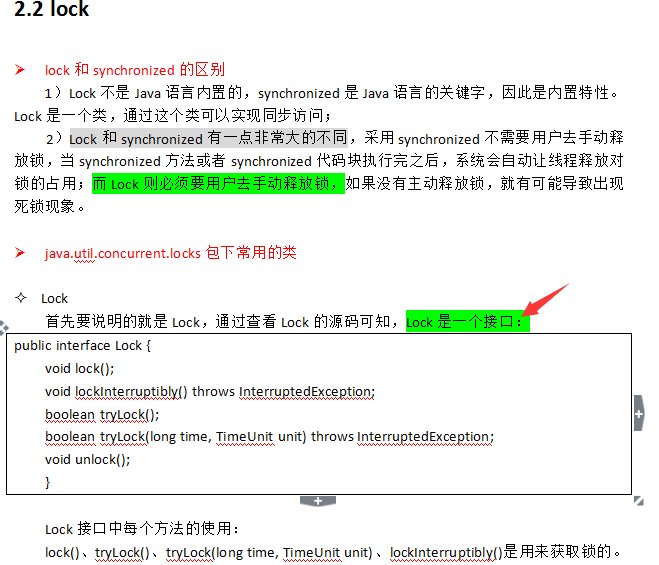day 04 Java并发多线程
http://www.cnblogs.com/hellocsl/p/3969768.html?utm_source=tuicool&utm_medium=referral
PS:而JVM 每遇到一个线程,就为其分配一个Program Counter Register(程序计数器), VM Stack(虚拟机栈)和Native Method Stack (本地方法栈)
引用别人的博客,关于Java内存管理,博客很好
并发编程的挑战


PS: 轻量级volatile



---------------------------------------------------

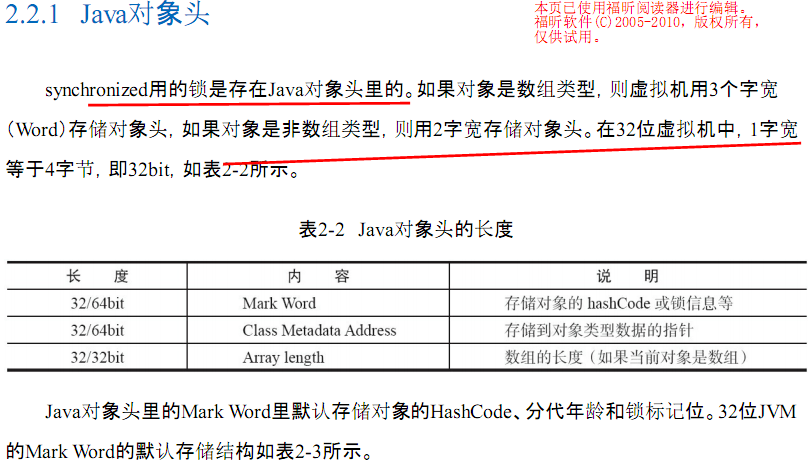
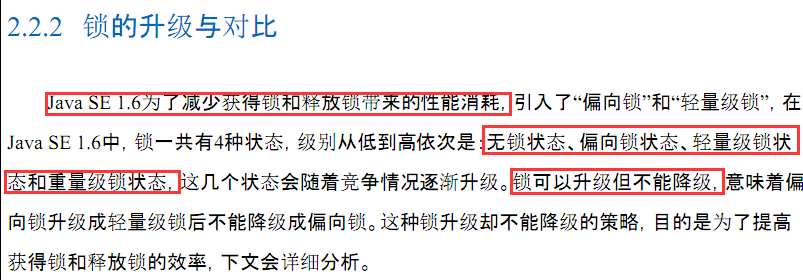
PS: 上述 看清是四种 状态。 目的是为了 减小获得和释放锁的性能消耗

PS: 出现那么多的锁就是为了减少 获得锁和释放锁的 性能消耗; 而且锁只能升级不能降级


/**
* Alipay.com Inc.
* Copyright (c) 2004-2015 All Rights Reserved.
*/
package chapter02; import java.util.ArrayList;
import java.util.List;
import java.util.concurrent.atomic.AtomicInteger; /**
* 计数器
*
* @author tengfei.fangtf
* @version $Id: Snippet.java, v 0.1 2015-7-31 下午11:32:42 tengfei.fangtf Exp $
*/
public class Counter { private AtomicInteger atomicI = new AtomicInteger(0);
private int i = 0; public static void main(String[] args) {
final Counter cas = new Counter();
List<Thread> ts = new ArrayList<Thread>(600);
long start = System.currentTimeMillis();
for (int j = 0; j < 100; j++) {
Thread t = new Thread(new Runnable() {
@Override
public void run() {
for (int i = 0; i < 10000; i++) {
cas.count();
cas.safeCount();
}
}
});
ts.add(t);
}
for (Thread t : ts) {
t.start(); }
// 等待所有线程执行完成
for (Thread t : ts) {
try {
t.join();
} catch (InterruptedException e) {
e.printStackTrace();
} }
System.out.println(cas.i);
System.out.println(cas.atomicI.get()); //获取值
System.out.println(System.currentTimeMillis() - start);
} /**
* 使用CAS实现线程安全计数器
*/
private void safeCount() {
for (;;) {
int i = atomicI.get();
boolean suc = atomicI.compareAndSet(i, ++i);
if (suc) {
break;
}
}
} /**
* 非线程安全计数器
*/
private void count() {
i++;//一个cpu加了,但是另一个不一定加
} } PS: 原子性的那个操作一直都不会变

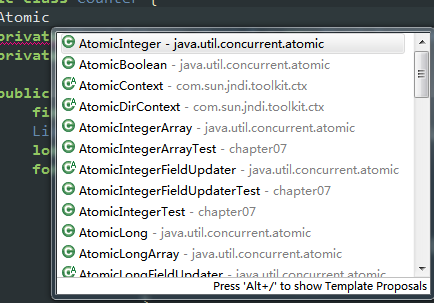



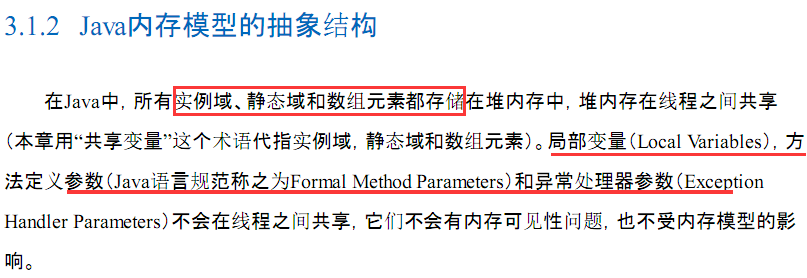

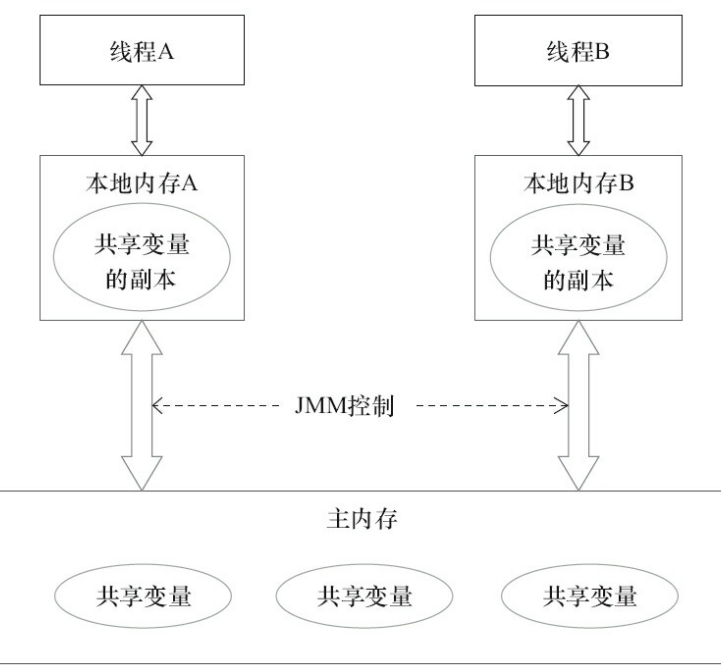




PS: main方法天生就是一个多线程
package chapter04; import java.lang.management.ManagementFactory;
import java.lang.management.ThreadInfo;
import java.lang.management.ThreadMXBean; /**
* 6-1
*/
public class MultiThread { public static void main(String[] args) {
// 获取Java线程管理MXBean
ThreadMXBean threadMXBean = ManagementFactory.getThreadMXBean();
// 不需要获取同步的monitor和synchronizer信息,仅仅获取线程和线程堆栈信息
ThreadInfo[] threadInfos = threadMXBean.dumpAllThreads(false, false);
// 遍历线程信息,仅打印线程ID和线程名称信息
for (ThreadInfo threadInfo : threadInfos) {
System.out.println("[" + threadInfo.getThreadId() + "] " + threadInfo.getThreadName());
}
}
}
PS : suspend 、resume 、stop方法

PS: 优雅的结束线程
package chapter04; import java.util.concurrent.TimeUnit; /**
* 6-9
*/
public class Shutdown {
public static void main(String[] args) throws Exception {
Runner one = new Runner();
Thread countThread = new Thread(one, "CountThread");
countThread.start();
// 睡眠1秒,main线程对CountThread进行中断,使CountThread能够感知中断而结束
TimeUnit.SECONDS.sleep(1);
countThread.interrupt();
Runner two = new Runner();
countThread = new Thread(two, "CountThread");
countThread.start();
// 睡眠1秒,main线程对Runner two进行取消,使CountThread能够感知on为false而结束
TimeUnit.SECONDS.sleep(1);
two.cancel();
} private static class Runner implements Runnable {
private long i; private volatile boolean on = true; @Override
public void run() {
while (on && !Thread.currentThread().isInterrupted()) {
i++;
}
System.out.println("Count i = " + i);
} public void cancel() {
on = false;
}
}
}
PS: 当java虚拟机中存在 Daemon线程的时候,java虚拟机会退出
package chapter04; /**
* 6-5
*/
public class Daemon { public static void main(String[] args) {
Thread thread = new Thread(new DaemonRunner());
thread.setDaemon(true);
thread.start();
} static class DaemonRunner implements Runnable {
@Override
public void run() {
try {
SleepUtils.second(100);
} finally {
System.out.println("DaemonThread finally run.");
}
}
}
}
///什么也没有执行


Java并发编程:深入剖析ThreadLocal
-------------------------------------------------------------------------------------------------------------------------
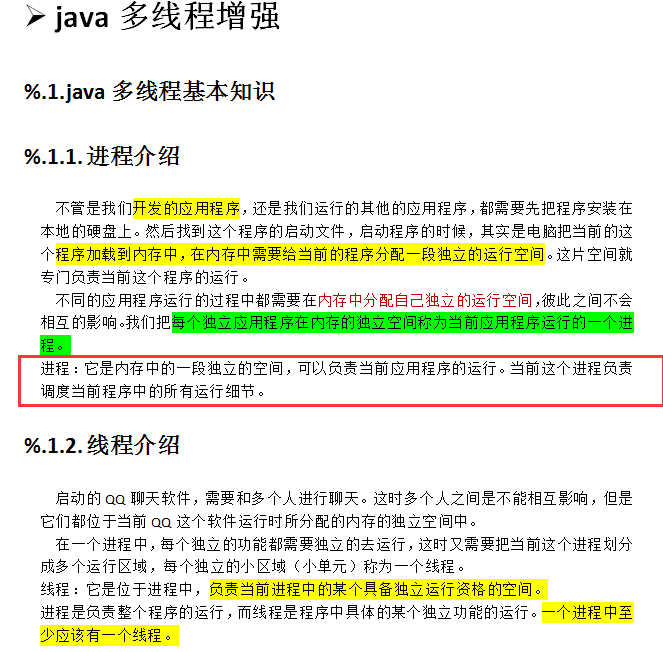
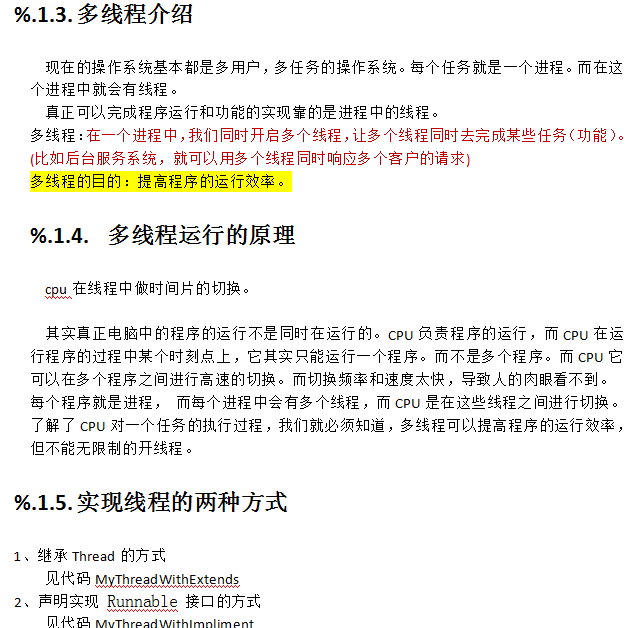

PS:进程通俗的讲就是一个应用程序, 太会在 内存中分配独立的运行空间
线程:它是位于进程中,负责当前进程中的某个具备独立运行资格的空间。
.1.1. synchronized

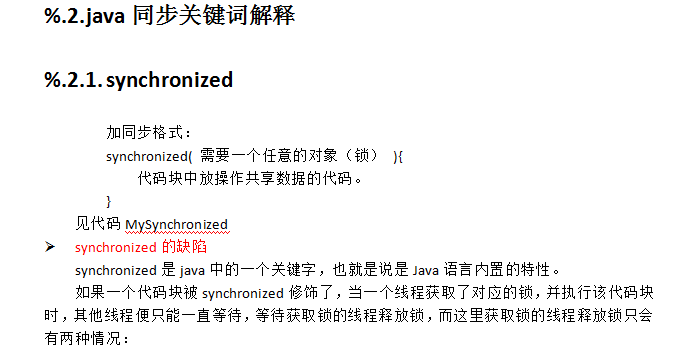

package cn.itcast_01_mythread.thread.testThread;
public class MySynchronized {
public static void main(String[] args) {
final MySynchronized mySynchronized = new MySynchronized();//这才是公用的锁
final MySynchronized mySynchronized2 = new MySynchronized();
new Thread("thread1") {
public void run() {
synchronized (mySynchronized) {
try {
System.out.println(this.getName()+" start");
int i =1/0; //如果发生异常,jvm会将锁释放
Thread.sleep(5000);
System.out.println(this.getName()+"醒了");
System.out.println(this.getName()+" end");
} catch (InterruptedException e) {
e.printStackTrace();
}
}
}
}.start();
new Thread("thread2") {
public void run() {
synchronized (mySynchronized) { //争抢同一把锁时,线程1没释放之前,线程2只能等待
// synchronized (mySynchronized2) { //如果不是一把锁,可以看到两句话同时打印
System.out.println(this.getName()+" start");
System.out.println(this.getName()+" end");
}
}
}.start();
}
}
- synchronized的缺陷
synchronized是java中的一个关键字,也就是说是Java语言内置的特性。
如果一个代码块被synchronized修饰了,当一个线程获取了对应的锁,并执行该代码块时,其他线程便只能一直等待,等待获取锁的线程释放锁,而这里获取锁的线程释放锁只会有两种情况:
1)获取锁的线程执行完了该代码块,然后线程释放对锁的占有;
2)线程执行发生异常(他挂了),此时JVM会让线程自动释放锁。
------------------------------------------------------------
PS:也就是 释放锁有两种方式 自己释放;自己挂了。

---------------------------------------------------------------------------------------
PS :因为Synchronoied使用起来不方便,java5以后出现了Lock

PS : CountDownLatch、ReentrantLock和ReentrantReadWriteLock都是同步组件




package chapter05; import java.util.concurrent.locks.Condition;
import java.util.concurrent.locks.Lock;
import java.util.concurrent.locks.ReentrantLock; /**
* 10-20
*/
public class ConditionUseCase {
Lock lock = new ReentrantLock();
Condition condition = lock.newCondition(); public void conditionWait() throws InterruptedException {
lock.lock();
try {
condition.await();
} finally {
lock.unlock();
}
} public void conditionSignal() throws InterruptedException {
lock.lock();
try {
condition.signal();
} finally {
lock.unlock();
}
}
}


Answer: 1.因为HashMap会照成环形数据结构,一直有next,然后就死锁了
2.HashTable使用synchronied并发效率非常低下





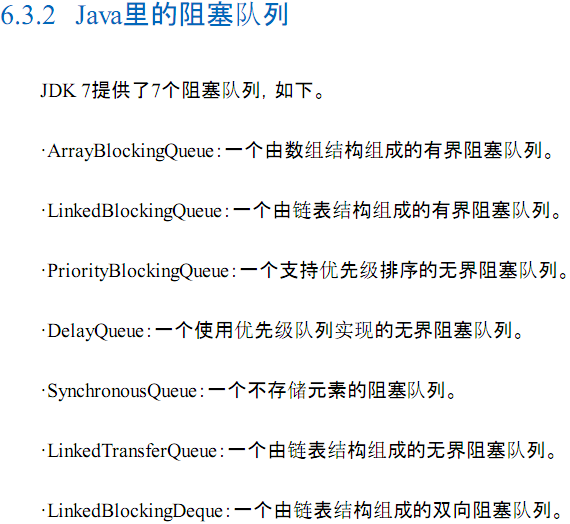



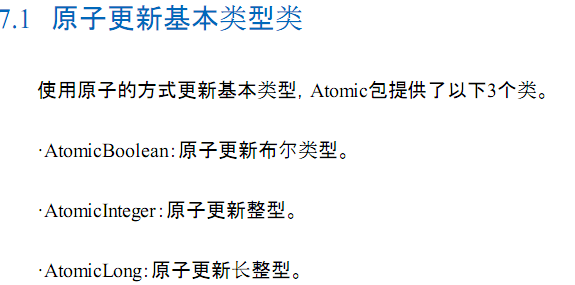
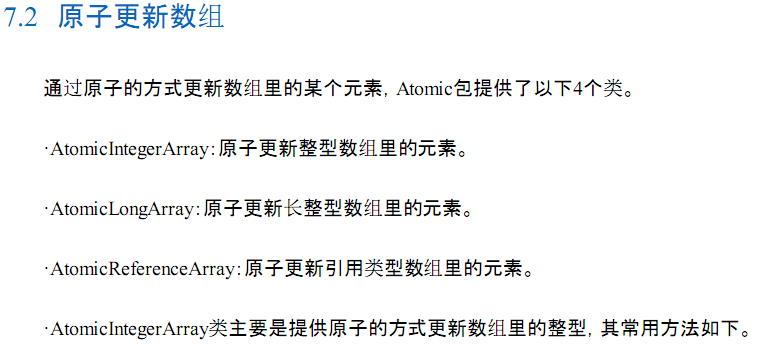




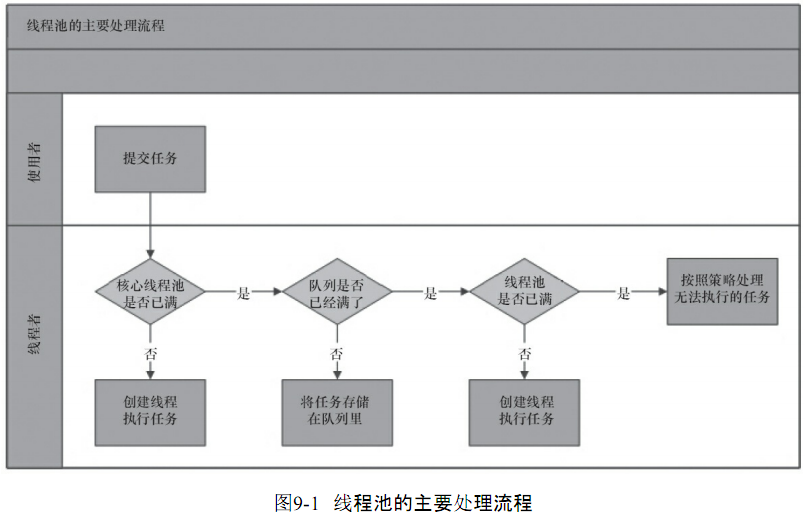


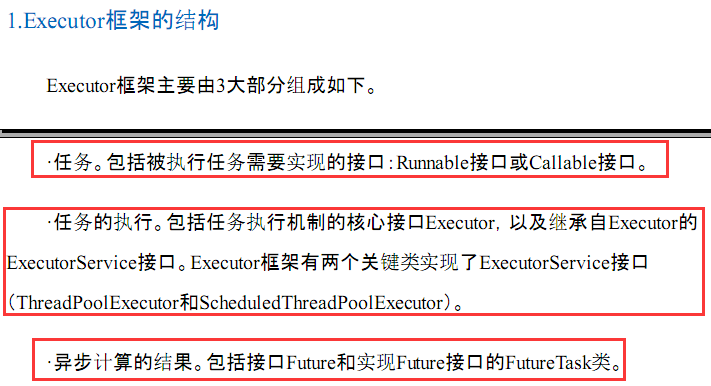
PS: Synchronizd


PS :ReentrantLock是唯一实现Lock的接口
PS:lock的用法
import java.util.ArrayList;
import java.util.concurrent.locks.Lock;
import java.util.concurrent.locks.ReentrantLock; public class MyLockTest {
private static ArrayList<Integer> arrayList = new ArrayList<Integer>();
static Lock lock = new ReentrantLock(); // 注意这个地方,因为Lock是一个借口,通常ReentrantLock进行实现
public static <E> void main(String[] args) {
new Thread() {
public void run() {
Thread thread = Thread.currentThread(); lock.lock();//获取锁
try {
System.out.println(thread.getName() + "得到了锁");
for (int i = 0; i < 5; i++) {
arrayList.add(i);
}
} catch (Exception e) {
// TODO: handle exception
} finally {
System.out.println(thread.getName() + "释放了锁");
lock.unlock();//不释放就死锁了
} };
}.start(); new Thread() {
public void run() {
Thread thread = Thread.currentThread();
lock.lock();
try {
System.out.println(thread.getName() + "得到了锁");
for (int i = 0; i < 5; i++) {
arrayList.add(i);
}
} catch (Exception e) {
// TODO: handle exception
} finally {
System.out.println(thread.getName() + "释放了锁");
lock.unlock();
} };
}.start();
} }
PS:每次需要手动关闭锁
tryLock()方法是有返回值的,它表示用来尝试获取锁,如果获取成功,则返回true,如果获取失败(即锁已被其他线程获取),则返回false,也就说这个方法无论如何都会立即返回。在拿不到锁时不会一直在那等待。
 PS:他会尝试获取锁
PS:他会尝试获取锁

import java.util.ArrayList;
import java.util.concurrent.locks.Lock;
import java.util.concurrent.locks.ReentrantLock; /**
* 观察现象:一个线程获得锁后,另一个线程取不到锁,不会一直等待
* @author
*
*/
public class MyTryLock { private static ArrayList<Integer> arrayList = new ArrayList<Integer>();
static Lock lock = new ReentrantLock(); // 注意这个地方
public static void main(String[] args) { new Thread() {
public void run() {
Thread thread = Thread.currentThread();
boolean tryLock = lock.tryLock();
System.out.println(thread.getName()+" "+tryLock);
if (tryLock) {
try {
System.out.println(thread.getName() + "得到了锁");
for (int i = 0; i < 5; i++) {
arrayList.add(i);
}
} catch (Exception e) {
// TODO: handle exception
} finally {
System.out.println(thread.getName() + "释放了锁");
lock.unlock();
}
}
};
}.start(); new Thread() {
public void run() {
Thread thread = Thread.currentThread();
boolean tryLock = lock.tryLock();
System.out.println(thread.getName()+" "+tryLock);
if (tryLock) {
try {
System.out.println(thread.getName() + "得到了锁");
for (int i = 0; i < 5; i++) {
arrayList.add(i);
}
} catch (Exception e) {
// TODO: handle exception
} finally {
System.out.println(thread.getName() + "释放了锁");
lock.unlock();
}
} };
}.start();
} }
PS:一旦某个线程tryLock false以后, 其他线程就获取不了 了
|
当两个线程同时通过lock.lockInterruptibly()想获取某个锁时,假若此时线程A获取到了锁,而线程B只有等待,那么对线程B调用threadB.interrupt()方法能够中断线程B的等待过程(并非中断A的操作)。 注意,当一个线程获取了锁之后,是不会被interrupt()方法中断的。 因此当通过lockInterruptibly()方法获取某个锁时,如果不能获取到,只有进行等待的情况下,是可以响应中断的。 |
package cn.itcast_01_mythread.thread.lock; import java.util.concurrent.locks.Lock;
import java.util.concurrent.locks.ReentrantLock;
/**
* 观察现象:如果thread-0得到了锁,阻塞。。。thread-1尝试获取锁,如果拿不到,则可以被中断等待
* @author
*
*/
public class MyInterruptibly {
private Lock lock = new ReentrantLock(); public static void main(String[] args) {
MyInterruptibly test = new MyInterruptibly();
MyThread thread0 = new MyThread(test);
MyThread thread1 = new MyThread(test);
thread0.start();
thread1.start(); try {
Thread.sleep(2000);
} catch (InterruptedException e) {
e.printStackTrace();
}
thread1.interrupt(); //如果线程1 陷入等待, 这可以让他结束等待
System.out.println("=====================");
} public void insert(Thread thread) throws InterruptedException{
lock.lockInterruptibly(); //注意,如果需要正确中断等待锁的线程,必须将获取锁放在外面,然后将InterruptedException抛出
try {
System.out.println(thread.getName()+"得到了锁");
//long startTime = System.currentTimeMillis();
//for( ; ;) {
/*if(System.currentTimeMillis() - startTime >= Integer.MAX_VALUE)
break;*/
//插入数据
//}
Thread.sleep(5000);
}
finally {
System.out.println(Thread.currentThread().getName()+"执行finally");
lock.unlock();
System.out.println(thread.getName()+"释放了锁");
}
}
}
class MyThread extends Thread {
private MyInterruptibly test = null;
public MyThread(MyInterruptibly test) {
this.test = test;
}
@Override
public void run() {
try {
test.insert(Thread.currentThread());
} catch (Exception e) {
System.out.println(Thread.currentThread().getName()+"被中断");
}
}
}
PS : ReadWriteLock
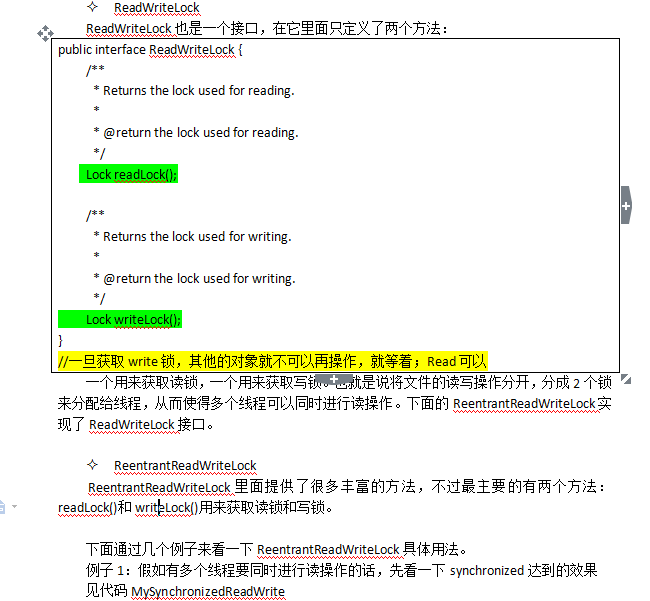
package cn.itcast_01_mythread.thread.lock; /**
* 一个线程又要读又要写,用synchronize来实现的话,读写操作都只能锁住后一个线程一个线程地进行
* @author
*
*/
public class MySynchronizedReadWrite { public static void main(String[] args) {
final MySynchronizedReadWrite test = new MySynchronizedReadWrite(); new Thread(){
public void run() {
test.get(Thread.currentThread());
};
}.start(); new Thread(){
public void run() {
test.get(Thread.currentThread());
};
}.start(); } public synchronized void get(Thread thread) {
long start = System.currentTimeMillis();
int i=0;
while(System.currentTimeMillis() - start <= 1) {//执行时间不操过1s
i++;
if(i%4==0){
System.out.println(thread.getName()+"正在进行写操作");
}else {
System.out.println(thread.getName()+"正在进行读操作");
}
}
System.out.println(thread.getName()+"读写操作完毕");
} }
|
Thread-0正在进行读操作 |
读写锁:读的时候,其他线程还可以操作,写的时候绝对不行。 里面有两个方法
import java.util.concurrent.locks.ReentrantReadWriteLock; /**
* 使用读写锁,可以实现读写分离锁定,读操作并发进行,写操作锁定单个线程
*
* 如果有一个线程已经占用了读锁,则此时其他线程如果要申请写锁,则申请写锁的线程会一直等待释放读锁。
* 如果有一个线程已经占用了写锁,则此时其他线程如果申请写锁或者读锁,则申请的线程会一直等待释放写锁。
PS : 多线程就是可以同时读操作,写操作的时候不可以读,读的时候不可以写
* @author
*
*bee:读的时候多个线程可以同时操作, 写线程不能操作
*/
public class MyReentrantReadWriteLock {
private ReentrantReadWriteLock rwl = new ReentrantReadWriteLock();
public static void main(String[] args) {
final MyReentrantReadWriteLock test = new MyReentrantReadWriteLock();
new Thread(){
public void run() {
test.get(Thread.currentThread());
test.write(Thread.currentThread());
};
}.start();
new Thread(){
public void run() {
test.get(Thread.currentThread());
test.write(Thread.currentThread());
};
}.start();
}
/**
* 读操作,用读锁来锁定
* @param thread
*/
public void get(Thread thread) {
rwl.readLock().lock();
try {
long start = System.currentTimeMillis();
while(System.currentTimeMillis() - start <= 1) {
System.out.println(thread.getName()+"正在进行读操作");
}
System.out.println(thread.getName()+"读操作完毕");
} finally {
rwl.readLock().unlock();
}
}
/**
* 写操作,用写锁来锁定
* @param thread
*/
public void write(Thread thread) {
rwl.writeLock().lock();;
try {
long start = System.currentTimeMillis();
while(System.currentTimeMillis() - start <= 1) {
System.out.println(thread.getName()+"正在进行写操作");
}
System.out.println(thread.getName()+"写操作完毕");
} finally {
rwl.writeLock().unlock();
}
}
}

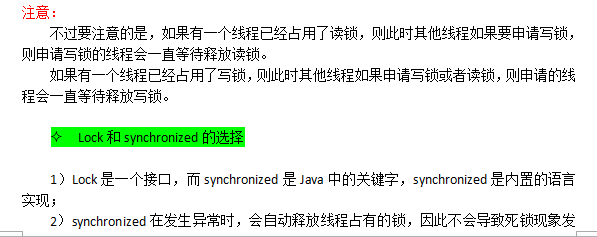

---------------------------------------------------
1.3 关于volatile的介绍
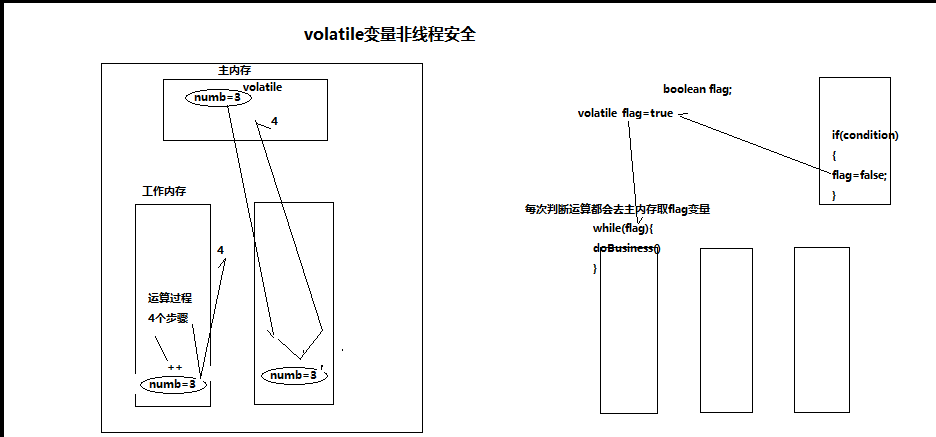
package cn.itcast_01_mythread.volatiletest;
public class TestVolatile {
public static volatile int numb = 0;
public static void main(String[] args) throws Exception {
for (int i = 0; i < 100; i++) {
new Thread(new Runnable() {
@Override
public void run() {
for (int i = 0; i < 1000; i++) {
numb++;
}
}
}).start();
}
Thread.sleep(2000);
System.out.println(numb);
}
}
PS: 因为 每当启动一个线程的时候都会创建一个栈内存,他们共享着堆空间的数据。当想要对 堆上某个数据进行操作的时候,
就会复制相应的数据到 自己的栈空间 进行操作, volatile就是为了各个线程间同步数据的问题。
这和synchronized还不太一样,synchronized是完全把数据上锁了。 volatile还用是提高数据保存的位置。
1.4 并发的执行

PS:当抢小米手机的时候,通常会异步解耦。其实就是一个修改库存的过程,成千上万个用户同时访问服务器,服务器这边会使用线程池对线程进行管理,防止创建线程过多,服务器奔溃。
同时,会使用任务消息队列 ,在java中使用 JMS规范的ActiveMQ(为了解决大并发的请求,放入编写好的消息队列中)来解决。比如,有5台手机,有100人发起请求,前五个线程可以获得手机,后面直接提示jj。这样一个解耦
- PS: 线程是不可以无限增长的,所以用一个线程池进行管理



package cn.itcast_01_mythread.pool; import java.util.ArrayList;
import java.util.HashMap;
import java.util.Random;
import java.util.concurrent.ExecutorService;
import java.util.concurrent.Executors;
import java.util.concurrent.Future;
import java.util.concurrent.ScheduledExecutorService;
import java.util.concurrent.TimeUnit; import com.sun.corba.se.impl.encoding.OSFCodeSetRegistry.Entry; public class TestPool { public static void main(String[] args) throws Exception {
Future<?> submit = null;
Random random = new Random(); //创建固定数量线程池
ExecutorService exec = Executors.newFixedThreadPool(4); //创建调度线程池
//ScheduledExecutorService exec = Executors.newScheduledThreadPool(4); //用来记录各线程的返回结果
ArrayList<Future<?>> results = new ArrayList<Future<?>>(); for (int i = 0; i < 10; i++) {
//fixedPool提交线程,runnable无返回值,callable有返回值
submit = exec.submit(new TaskRunnable(i));
/*submit = exec.submit(new TaskCallable(i));*/ //对于schedulerPool来说,调用submit提交任务时,跟普通pool效果一致
/*submit = exec.submit(new TaskCallable(i));*/
//对于schedulerPool来说,调用schedule提交任务时,则可按延迟,按间隔时长来调度线程的运行
//submit = exec.schedule(new TaskCallable(i), random.nextInt(10), TimeUnit.SECONDS);
//存储线程执行结果
results.add(submit); } //打印结果
for(Future f: results){
boolean done = f.isDone();
System.out.println(done?"已完成":"未完成"); //从结果的打印顺序可以看到,即使未完成,也会阻塞等待
System.out.println("线程返回future结果: " + f.get());
} exec.shutdown(); }
}
pool-1-thread-1 启动时间:1510802909
未完成
pool-1-thread-3 启动时间:1510802909
pool-1-thread-4 启动时间:1510802909
pool-1-thread-2 启动时间:1510802909
pool-1-thread-1 is working...0
线程返回future结果: null
未完成
pool-1-thread-1 启动时间:1510802909
pool-1-thread-3 is working...2
pool-1-thread-3 启动时间:1510802909
pool-1-thread-1 is working...4
pool-1-thread-1 启动时间:1510802909
pool-1-thread-2 is working...1
线程返回future结果: null
pool-1-thread-2 启动时间:1510802910
已完成
线程返回future结果: null
未完成
pool-1-thread-1 is working...6
pool-1-thread-3 is working...5
pool-1-thread-1 启动时间:1510802910
pool-1-thread-3 启动时间:1510802910
pool-1-thread-4 is working...3
线程返回future结果: null
已完成
线程返回future结果: null
已完成
线程返回future结果: null
已完成
线程返回future结果: null
未完成
pool-1-thread-3 is working...9
pool-1-thread-1 is working...8
pool-1-thread-2 is working...7
线程返回future结果: null
已完成
线程返回future结果: null
已完成
线程返回future结果: null
PS :Runnable和Callanble的区别
package cn.itcast_01_mythread.pool; import java.util.concurrent.ExecutorService;
import java.util.concurrent.Executors; public class ThreadPoolWithRunable { /**
* 通过线程池执行线程
* @param args
*/
public static void main(String[] args) {
//创建一个线程池
ExecutorService pool = Executors.newCachedThreadPool();
for(int i = 1; i < 5; i++){
pool.execute(new Runnable() {//提交任务
@Override
public void run() {
System.out.println("thread name: " + Thread.currentThread().getName());
try {
Thread.sleep(1000);
} catch (InterruptedException e) {
e.printStackTrace();
}
}
});
}
pool.shutdown();
} }
提交 Callable,该方法返回一个 Future 实例表示任务的状态
调用submit提交任务, 匿名Callable,重写call方法, 有返回值, 获取返回值会阻塞,一直要等到线程任务返回结果
见代码:ThreadPoolWithcallable
pool-1-thread-1 启动时间:1510803239
pool-1-thread-2 启动时间:1510803239
pool-1-thread-2 is working...1
pool-1-thread-2 启动时间:1510803239
pool-1-thread-3 启动时间:1510803239
未完成
pool-1-thread-4 启动时间:1510803239
pool-1-thread-4 is working...3
pool-1-thread-4 启动时间:1510803239
pool-1-thread-4 is working...5
pool-1-thread-4 启动时间:1510803239
pool-1-thread-1 is working...0
线程返回future结果: 0
已完成
线程返回future结果: 1
未完成
pool-1-thread-1 启动时间:1510803240
pool-1-thread-3 is working...2
线程返回future结果: 2
已完成
线程返回future结果: 3
未完成
pool-1-thread-3 启动时间:1510803240
pool-1-thread-2 is working...4
线程返回future结果: 4
pool-1-thread-2 启动时间:1510803241
已完成
线程返回future结果: 5
未完成
pool-1-thread-1 is working...7
pool-1-thread-4 is working...6
线程返回future结果: 6
已完成
线程返回future结果: 7
未完成
pool-1-thread-3 is working...8
线程返回future结果: 8
未完成
pool-1-thread-2 is working...9
线程返回future结果: 9
package cn.itcast_01_mythread.pool; import java.util.ArrayList;
import java.util.HashMap;
import java.util.Random;
import java.util.concurrent.ExecutorService;
import java.util.concurrent.Executors;
import java.util.concurrent.Future;
import java.util.concurrent.ScheduledExecutorService;
import java.util.concurrent.TimeUnit; import com.sun.corba.se.impl.encoding.OSFCodeSetRegistry.Entry; public class TestPool { public static void main(String[] args) throws Exception {
Future<?> submit = null;
Random random = new Random(); //创建固定数量线程池
ExecutorService exec = Executors.newFixedThreadPool(4); //创建调度线程池
//ScheduledExecutorService exec = Executors.newScheduledThreadPool(4); //用来记录各线程的返回结果
ArrayList<Future<?>> results = new ArrayList<Future<?>>(); for (int i = 0; i < 10; i++) {
//fixedPool提交线程,runnable无返回值,callable有返回值
//submit = exec.submit(new TaskRunnable(i));
submit = exec.submit(new TaskCallable(i)); //对于schedulerPool来说,调用submit提交任务时,跟普通pool效果一致
/*submit = exec.submit(new TaskCallable(i));*/
//对于schedulerPool来说,调用schedule提交任务时,则可按延迟,按间隔时长来调度线程的运行
//submit = exec.schedule(new TaskCallable(i), random.nextInt(10), TimeUnit.SECONDS);
//存储线程执行结果
results.add(submit); } //打印结果
for(Future f: results){
boolean done = f.isDone();
System.out.println(done?"已完成":"未完成"); //从结果的打印顺序可以看到,即使未完成,也会阻塞等待
System.out.println("线程返回future结果: " + f.get());
} exec.shutdown(); }
}
package cn.itcast_01_mythread.pool; import java.util.ArrayList;
import java.util.List;
import java.util.concurrent.Callable;
import java.util.concurrent.ExecutionException;
import java.util.concurrent.ExecutorService;
import java.util.concurrent.Executors;
import java.util.concurrent.Future;
/**
* callable 跟runnable的区别:
* runnable的run方法不会有任何返回结果,所以主线程无法获得任务线程的返回值
*
* callable的call方法可以返回结果,但是主线程在获取时是被阻塞,需要等待任务线程返回才能拿到结果
*
*/
public class ThreadPoolWithcallable { public static void main(String[] args) throws InterruptedException, ExecutionException {
ExecutorService pool = Executors.newFixedThreadPool(4); for(int i = 0; i < 10; i++){
Future<String> submit = pool.submit(new Callable<String>(){//线程是有返回值的
@Override
public String call() throws Exception {
//System.out.println("a");
Thread.sleep(5000);
return "b--"+Thread.currentThread().getName();
}
});
//从Future中get结果,这个方法是会被阻塞的,一直要等到线程任务执行完成 才能返回结果!!!!!
所以一般不要使用,他会阻塞主线程,如果必须想要得到结果在使用
System.out.println(submit.get());,
}
pool.shutdown(); } }
package cn.itcast_01_mythread.pool; import java.util.concurrent.ExecutorService;
import java.util.concurrent.Executors;
import java.util.concurrent.ScheduledExecutorService; /**
* 列出并发包中的各种线程池
* @author
*
*/ public class ExecutorDemo { public static void main(String[] args) {
ExecutorService newSingleThreadExecutor = Executors.newSingleThreadExecutor();//单线程,任务顺序执行
//线程池里有很多线程需要同时执行,老的可用线程将被新的任务触发重新执行,
//如果线程超过60秒内没执行,那么将被终止并从池中删除,
ExecutorService newCachedThreadPool = Executors.newCachedThreadPool();
int cpuNums = Runtime.getRuntime().availableProcessors();
System.out.println(cpuNums);//CPU的核数
//在构造函数中的参数4是线程池的大小,你可以随意设置,也可以和cpu的核数量保持
ExecutorService newFixedThreadPool = Executors.newFixedThreadPool(cpuNums);
//用来调度即将执行的任务的线程池,可能是不是直接执行, 每隔多久执行一次... 策略型的
ScheduledExecutorService newScheduledThreadPool = Executors.newScheduledThreadPool(8); //只有一个线程,用来调度任务在指定时间执行
ScheduledExecutorService newSingleThreadScheduledExecutor = Executors.newSingleThreadScheduledExecutor();
}
}
PS:上面可以看到Runnable和callable分别是线程中的不同的实现方式。Runnable不会返回结果,而callable会返回结果,但是在拿结果的时候会阻塞。
在线程池中通过固定数量的线程进行相同的操作,有不同 的实现 。
.1. java并发包消息队列及在开源软件中的应用
BlockingQueue也是java.util.concurrent下的主要用来控制线程同步的工具。 类似与锁
主要的方法是:put、take一对阻塞存取;add、poll一对非阻塞存取。
插入:
1)add(anObject):把anObject加到BlockingQueue里,即如果BlockingQueue可以容纳,则返回true,否则抛出异常,不好
2)offer(anObject):表示如果可能的话,将anObject加到BlockingQueue里,即如果BlockingQueue可以容纳,则返回true,否则返回false.
3)put(anObject):把anObject加到BlockingQueue里,如果BlockQueue没有空间,则调用此方法的线程被阻断直到BlockingQueue里面有空间再继续, 有阻塞, 放不进去就等待
读取:
4)poll(time):取走BlockingQueue里排在首位的对象,若不能立即取出,则可以等time参数规定的时间,取不到时返回null;
5)take():取走BlockingQueue里排在首位的对象,若BlockingQueue为空,阻断进入等待状态直到Blocking有新的对象被加入为止; 阻塞, 取不到就一直等
其他
int remainingCapacity();返回队列剩余的容量,在队列插入和获取的时候,不要瞎搞,数 据可能不准, 不能保证数据的准确性
boolean remove(Object o); 从队列移除元素,如果存在,即移除一个或者更多,队列改 变了返回true
public boolean contains(Object o); 查看队列是否存在这个元素,存在返回true
int drainTo(Collection<? super E> c); //移除此队列中所有可用的元素,并将它们添加到给定 collection 中。取出放到集合中
int drainTo(Collection<? super E> c, int maxElements); 和上面方法的区别在于,指定了移 动的数量; 取出指定个数放到集合
BlockingQueue有四个具体的实现类,常用的两种实现类为:
1、ArrayBlockingQueue:一个由数组支持的有界阻塞队列,规定大小的BlockingQueue,其构造函数必须带一个int参数来指明其大小.其所含的对象是以FIFO(先入先出)顺序排序的。
2、LinkedBlockingQueue:大小不定的BlockingQueue,若其构造函数带一个规定大小的参数,生成的BlockingQueue有大小限制,若不带大小参数,所生成的BlockingQueue的大小由Integer.MAX_VALUE来决定.其所含的对象是以FIFO(先入先出)顺序排序的。
LinkedBlockingQueue 可以指定容量,也可以不指定,不指定的话,默认最大是Integer.MAX_VALUE,其中主要用到put和take方法,put方法在队列满的时候会阻塞直到有队列成员被消费,take方法在队列空的时候会阻塞,直到有队列成员被放进来。
LinkedBlockingQueue和ArrayBlockingQueue区别:
LinkedBlockingQueue和ArrayBlockingQueue比较起来,它们背后所用的数据结构不一样,导致LinkedBlockingQueue的数据吞吐量要大于ArrayBlockingQueue,但在线程数量很大时其性能的可预见性低于ArrayBlockingQueue.

生产者消费者的示例代码:
见代码
package cn.itcast_02_blockingqueue.main; import java.util.concurrent.BlockingQueue;
import java.util.concurrent.LinkedBlockingQueue; import cn.itcast_02_blockingqueue.consumer.Consumer;
import cn.itcast_02_blockingqueue.producer.Producer; public class Test {
public static void main(String[] args) throws Exception {
BlockingQueue<String> queue = new LinkedBlockingQueue<String>(2);
// BlockingQueue<String> queue = new LinkedBlockingQueue<String>();
// 不设置的话,LinkedBlockingQueue默认大小为Integer.MAX_VALUE
// BlockingQueue<String> queue = new ArrayBlockingQueue<String>(2);
Consumer consumer = new Consumer(queue);
Producer producer = new Producer(queue);
for (int i = 0; i < 3; i++) {
new Thread(producer, "Producer" + (i + 1)).start();//线程就是这样启动的
}
for (int i = 0; i < 5; i++) {
new Thread(consumer, "Consumer" + (i + 1)).start();
} new Thread(producer, "Producer" + (5)).start();
}
}
package cn.itcast_02_blockingqueue.producer;
import java.util.concurrent.BlockingQueue;
public class Producer implements Runnable {
BlockingQueue<String> queue;
public Producer(BlockingQueue<String> queue) {
this.queue = queue;
}
@Override
public void run() {
try {
System.out.println("I have made a product:"
+ Thread.currentThread().getName());
String temp = "A Product, 生产线程:"
+ Thread.currentThread().getName();
queue.put(temp);//如果队列是满的话,会阻塞当前线程
} catch (InterruptedException e) {
e.printStackTrace();
}
}
}
package cn.itcast_02_blockingqueue.consumer;
import java.util.concurrent.BlockingQueue;
public class Consumer implements Runnable{
BlockingQueue<String> queue;
public Consumer(BlockingQueue<String> queue){
this.queue = queue;
}
@Override
public void run() {
try {
String consumer = Thread.currentThread().getName();
System.out.println(consumer);
String temp = queue.take();//如果队列为空,会阻塞当前线程
System.out.println(consumer+"get a product:"+temp);
} catch (InterruptedException e) {
e.printStackTrace();
}
}
}
4.kafka 和 redis的应用,Storm中用到了很多的Blockquene

PS: 比如,双十一在大屏上显示实时的消费金额, 在上面我们讲到,kafka她类似于消息队列,spout从kafka中那数据,根据业务把数据分发到各个节点blot取出来处理。把每一个任务再细分拓扑,到redis,然后再显示到屏幕上。
比如你在淘宝上下订单,并不是保存到数据库那么简单的。
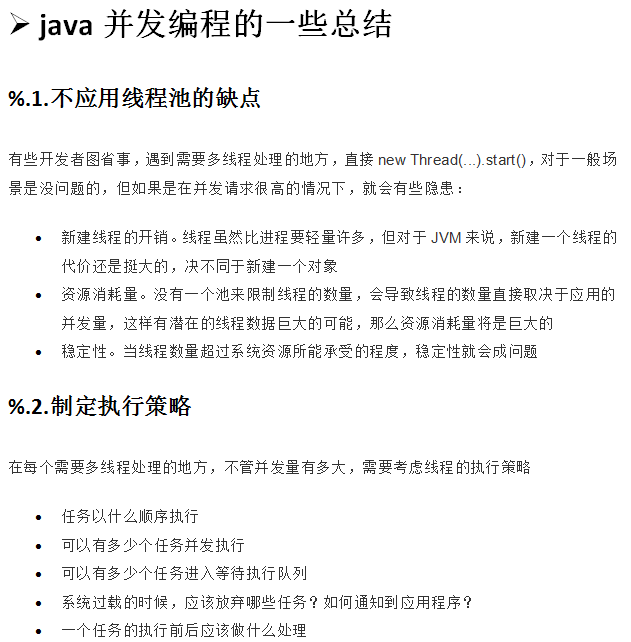
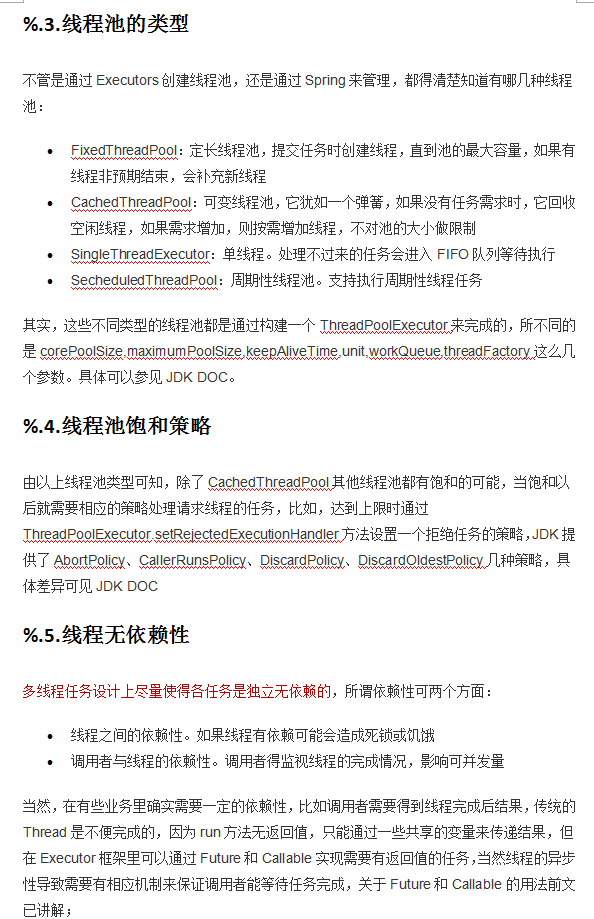
day 04 Java并发多线程的更多相关文章
- java并发多线程显式锁Condition条件简介分析与监视器 多线程下篇(四)
Lock接口提供了方法Condition newCondition();用于获取对应锁的条件,可以在这个条件对象上调用监视器方法 可以理解为,原本借助于synchronized关键字以及锁对象,配备了 ...
- java 并发多线程 锁的分类概念介绍 多线程下篇(二)
接下来对锁的概念再次进行深入的介绍 之前反复的提到锁,通常的理解就是,锁---互斥---同步---阻塞 其实这是常用的独占锁(排它锁)的概念,也是一种简单粗暴的解决方案 抗战电影中,经常出现为了阻止日 ...
- java 并发多线程显式锁概念简介 什么是显式锁 多线程下篇(一)
目前对于同步,仅仅介绍了一个关键字synchronized,可以用于保证线程同步的原子性.可见性.有序性 对于synchronized关键字,对于静态方法默认是以该类的class对象作为锁,对于实例方 ...
- Java并发多线程 - 并发工具类JUC
安全共享对象策略 1.线程限制 : 一个被线程限制的对象,由线程独占,并且只能被占有它的线程修改 2.共享只读 : 一个共享只读的对象,在没有额外同步的情况下,可以被多个线程并发访问, 但是任何线程都 ...
- Java并发/多线程系列——初识篇
回到过去,电脑有一个CPU,一次只能执行一个程序.后来多任务处理意味着计算机可以同时执行多个程序(AKA任务或进程).这不是真的"同时".单个CPU在程序之间共享.操作系统将在运行 ...
- Java并发(一)Java并发/多线程教程
在过去一台电脑只有单个CPU,并且在同一时间只能执行单个程序.后来出现的"多任务"意味着电脑在可以同时执行多个程序(AKA任务或者进程).虽然那并不是真正意义上的"同时& ...
- Java并发多线程面试题 Top 50
不管你是新程序员还是老手,你一定在面试中遇到过有关线程的问题.Java语言一个重要的特点就是内置了对并发的支持,让Java大受企业和程序员的欢迎.大多数待遇丰厚的Java开发职位都要求开发者精通多线程 ...
- Java并发-多线程面试(全面)
1. 什么是线程?2. 什么是线程安全和线程不安全?3. 什么是自旋锁?4. 什么是Java内存模型?5. 什么是CAS?6. 什么是乐观锁和悲观锁?7. 什么是AQS?8. 什么是原子操作?在Jav ...
- java并发多线程(摘自网络)
1. 进程和线程之间有什么不同? 一个进程是一个独立(self contained)的运行环境,它可以被看作一个程序或者一个应用.而线程是在进程中执行的一个任务.Java运行环境是一个包含了不同的类和 ...
随机推荐
- bzoj1666
题解: 简单模拟 按照题目意思来就可以了 代码: #include<bits/stdc++.h> using namespace std; int n,ans; int main() { ...
- OOP ⑴
1.面向对象 类和对象的关系 类是我们在生活中,对身边的一系列事物,进行的不自觉的分类! 只是脑海中的一个印象! 在现实生活中,不存在! 存在的是我们这个印象的具体反映! 对象:用来描述客观事物的一个 ...
- debian系统下安装ssh
SSH 为 Secure Shell 的缩写,SSH 为建立在应用层基础上的安全协议.SSH 是目前较可靠,专为远程登录会话和其他网络服务提供安全性的协议.利用 SSH 协议可以有效防止远程管理过程中 ...
- 深入理解java虚拟机---Class文件(二十)
无符号数.表 当实现了不同语言的编译器,比如jython,jruby等等,那么就可以利用这些语言编写代码,通过各自的编译器编译成符合jvm规范的字节码文件,就可以利用jvm来执行了. Class文件在 ...
- thymeleaf之下拉框回显选中
#1.select下拉框取值 <div class="form-group "> <label id="resource" ...
- TensorFlow函数:tf.ones_like
tf.ones_like 函数 ones_like( tensor, dtype=None, name=None, optimize=True ) 定义在:tensorflow/python/ops/ ...
- 2019-03-08-day007-深浅拷贝
01 昨日内容回顾 is 两者之间的id是否相同 == 两边的数值是否相等 id 获取该对象的内存地址 代码块: 一个文件,交互式命令行:一行是个一个代码块. 同一代码块下: 字符串的缓存机制,驻留机 ...
- Eclipse的配置
1 Eclipse的工作空间和新建工程 1.1: 工作空间 其实就是我们写的源代码所在的目录 1.2: 创建工程(项目) 右键/Package Explore 空白区/new /Java Projec ...
- [转]Spark 踩坑记:数据库(Hbase+Mysql)
https://cloud.tencent.com/developer/article/1004820 Spark 踩坑记:数据库(Hbase+Mysql) 前言 在使用Spark Streaming ...
- ORACLE异常处理及函数
有三种类型的异常错误 :预定义 ( Predefined )错误 ORACLE预定义的异常情况大约有24个.对这种异常情况的处理,无需在程序中定义,由ORACLE自动将其引发. 非预定义 ( Pred ...



